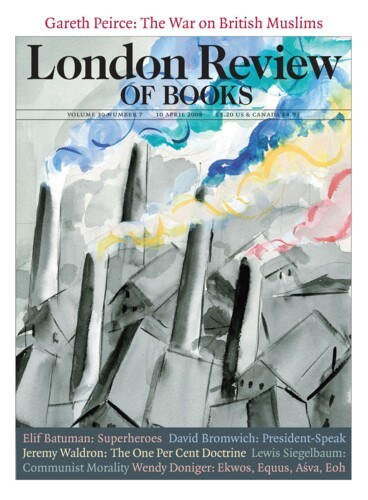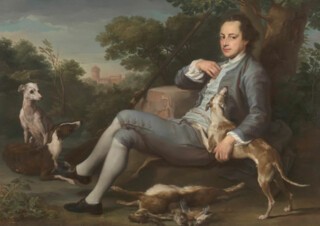A young Englishman of means passing through Rome on the Grand Tour in the mid to late 1700s might well have been directed to the studio of Pompeo Batoni to have his portrait painted. It would probably only have taken a couple of sessions for Batoni to get the sitter’s face onto canvas – the 12 he gave David Garrick were unusual. He made no preliminary drawings; when it came to finishing the figure a stand-in could take up the chosen position, usually a variation on a settled range of elegantly relaxed poses. Batoni, who was not cheap, was inclined to work faster if you paid part of the fee up front. He affronted the Duke and Duchess of Gloucester by demanding full payment before he delivered their pictures. But if Reynolds had painted you in London it would have set you back rather more, and a course on Roman antiquities could cost as much as your portrait.
Months or even years later the finished portrait would arrive at the family’s country seat. A famous piece of antique sculpture, the Colosseum, a plan of Rome or the landscape of the Roman Campagna would establish the scene (items of statuary, like the extra figures in double and triple portraits, seem to have incurred a surcharge). A flute, a crayon-holder, a dog at his feet, a map in his hand, a musical score or an open book would be a further indication of how the young gentleman had spent his time. He would usually be dressed brightly in red or blue, his coat and waistcoat laced with gold or silver, perhaps draped in a fur-lined cloak which, like the portrait itself, would probably have been an Italian-bought luxury. Variation in details of costume – a carefully careless arrangement of the black ribbon used to tie back hair, creases in a waistcoat (unbuttoned at the top), a contrast between sleeve and lining and the arrangement of ruffled linen – shows greater invention than the faces, the expressions on which are sedate, polite and suggest people well satisfied with the way the world has treated them. Garrick’s half-smile is unusually lively. A Van Dyck costume was not impossible, and if you were a military man your uniform coat would announce the fact. Colonel Gordon is dressed in full Highland costume: kilt, plaid and stockings all in the Huntly tartan, perhaps specially woven in silk to suit the Roman climate.
Portraits like these form a substantial part of the Batoni exhibition at the National Gallery (until 18 May). It has not drawn great crowds. It is advertised by a portrait of Richard Milles, which is typical in its confident projection of the sitter’s position and the painter’s skills; it could be that hackles are raised by the prospect of a succession of images of the privileged enjoying their time abroad and too much exposure to the confident swagger that is Batoni’s most original and engaging contribution. Certainly, the pleasures of the exhibition are not much reduced if you hold up a thumb to cover the face of some sprig of the aristocracy and admire instead the rendering of the clothes. In painting fabric Batoni skimped nothing. One reason he was slow to deliver was his inability to let things go when he thought he could improve them. To be fair, not all the faces are dull. Some of the later portraits, for example that of Mrs Robert Sandilands, remind you that projection of character – they almost bring David to mind – can be achieved without Gainsborough-style feathered brushwork, or Hals-style slashes.
Batoni, like many portrait painters with other strings to their bow, believed that his religious and mythological pictures were more significant than his portraits. They are composed with a florist’s feeling for arrangement: arms, hands, faces and drapery, studied in separate drawings, work as smoothly together as the wheels in a Swiss watch. Expressions are rarely so anguished or joyful as to disturb the sculptural perfection of the faces or break the rhythm set up by arms and hands. In The Ecstasy of St Catherine of Siena – a perfectly articulated group, lit with a strong sense of theatre – the saint has something of the self-consciousness of a player in a crime scene re-enactment. Batoni priced these pictures himself, and some were still on his hands when he died, the major assets of an estate that, reduced by his handsome style of living, could not meet the bequests made in his will. Yet he had been among the most famous Roman painters of his time, a skilful and conscientious pupil in a tradition whose sources included Raphael, Guido Reni and the Antique. In his time the tradition still had – and would have for some time – the power to draw young painters to Rome. Looking at his work now, though, one may feel that in his desire to emulate perfect examples, the flaccidity that distinguishes a tracing from the thing traced enters his art.
Yet the quality of what he was able to do is clear, even if it does seem to sap the vitality of the tradition he wished to embellish. His most finished drawings of ancient sculpture were made for collectors. A hundred years later Alinari started to take the photographs that would supplant drawings and engravings as records of works of art. Before then, Batoni’s perfectly graded hatching, one tone gliding into another, was as close a graphic simulation of marble as you were likely to get. There are equally finished life studies. It is a style of drawing that makes you hunger for a firm mark in which the activity of a hand guided by the eye can be discerned, yet the skill is undeniable.
The appetite for looking at paintings, like painting itself, is conditioned by time and place. There are things in Batoni which one can dislike, almost take pleasure in disliking because to do so reinforces the foundations of one’s preferences. Yet if reduced attendance figures make galleries regard exhibitions like this one as failures, if our lack of curiosity becomes a reason for curators to stick with what is known to be liked, loan exhibitions will cease to carry out one of their most significant functions: to make us think again about unfashionable art.
Send Letters To:
The Editor
London Review of Books,
28 Little Russell Street
London, WC1A 2HN
letters@lrb.co.uk
Please include name, address, and a telephone number.


